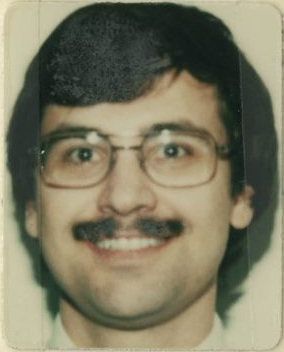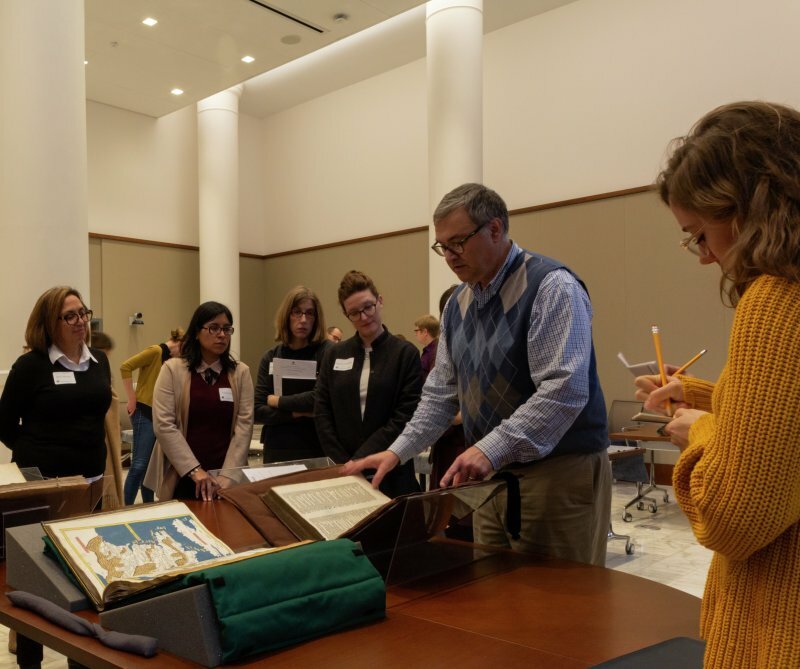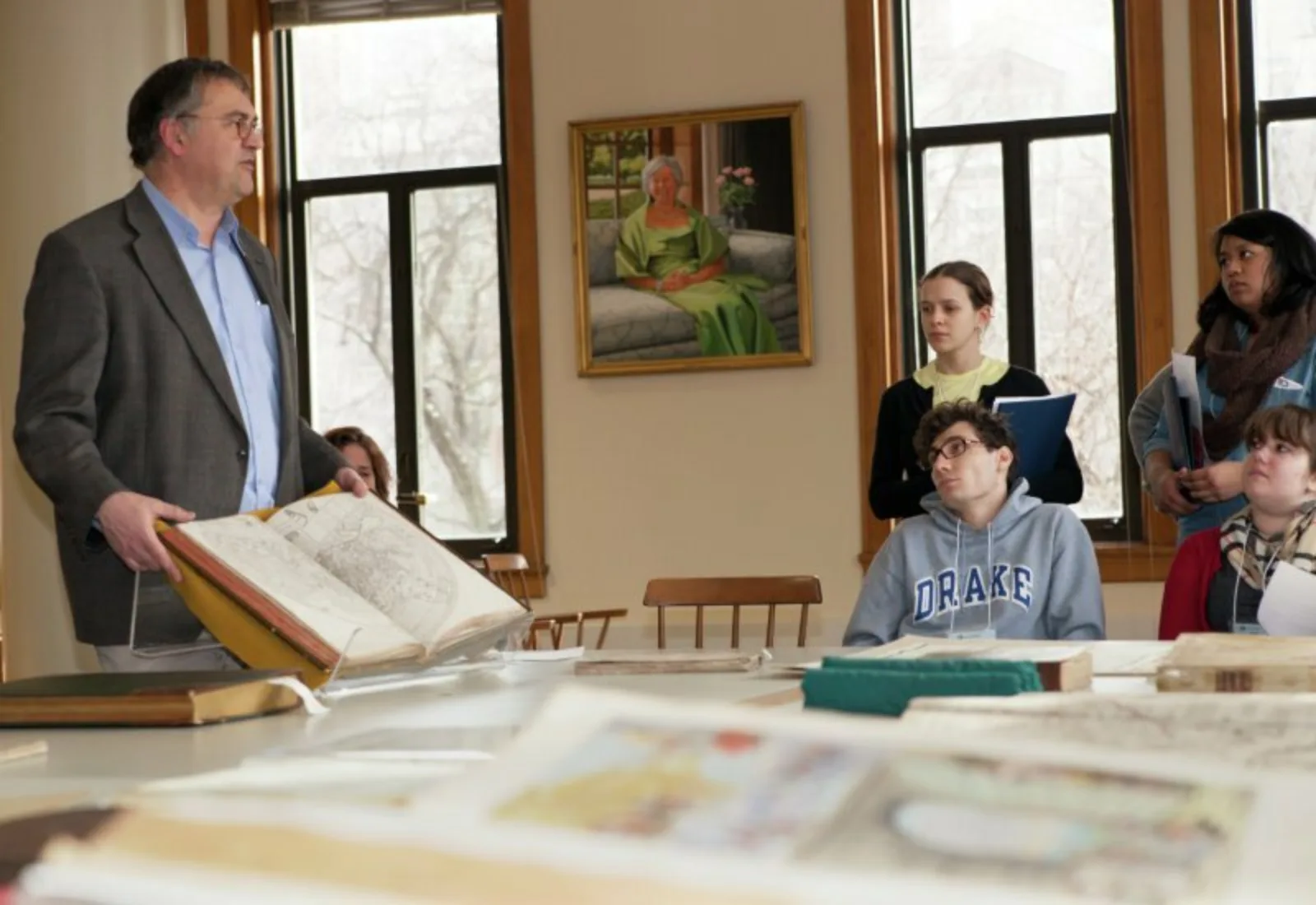James R. Akerman, Curator of Maps and Director of the Hermon Dunlap Smith Center for the History of Cartography, has worked at the Newberry for more than 35 years. Later this year, he will retire. In this edition of the Donor Digest, Jim talks with us about his career path, the unique challenges and delights he’s encountered in his various roles, and what he looks forward to post-retirement.
Can you tell us about your first encounter with the Newberry?
It was 45 years ago. I had a geography professor at Denison University, where I did my undergrad, who knew I was interested in maps. He told me about an Associated Colleges of the Midwest (ACM) program at the Newberry and said, “This program might interest you.”
Although I’d grown up in the western suburbs of Chicago, I’d never heard of the Newberry before that. I remember walking into the library in September 1977 and being very excited. It felt like the kind of place a young scholar would want to be, and I fell in love with it. It set the tone for what I decided I wanted to do with my graduate degrees.
I’ve always loved history and I’ve always loved maps. I liked to read historical atlases and collect roadmaps when I was a kid. When I came to the Newberry, it wasn’t that I suddenly discovered a love of map history. I discovered that I could actually make a living doing it and could help others do it too.
It sounds like your undergraduate experience at the Newberry was really influential. How did that experience shape your career decisions?
When I first entered college, I thought I was going to be a cartographer. But this was around the time when cartography was going into computers in a big way and that didn’t interest me. Being at the Newberry helped me realize that I was very interested in the visual qualities and history of maps.
I came back to the Newberry in the fall of 1984 while working on my PhD. I got a short-term fellowship and, obviously, loved it. In March of 1985, Bob Karrow, who was the Curator of Maps at the time, asked me if I wanted a job. I said yes, and I’ve been here ever since.
I didn’t expect it would be something I would be doing for more than 35 years. You don’t start out by saying, “I want to be a historian of cartography and work at a research library.” There just aren’t a lot of roles like that. But I guess I did well enough that people wanted to keep me on. For that, I’m extremely grateful and consider myself extremely lucky.

You have two titles: Curator of Maps and Director of the Smith Center. How do those roles interconnect and how are they distinct?
The relationship between the Smith Center Director and the Curator of Maps has always been a strong one. For center directors at the Newberry—there are four of us—there’s always a curatorial element. Likewise, there’s always a programming and research orientation for Newberry curators. It’s part of what makes the Newberry unique.
I’ve been Director since 1995 and Curator since 2011. In many ways, the Curator sets the table by shaping the collections, while the Director figures out how to get people to come to the table and use those collections. In retrospect, it’s a lot of work for one person to do, but it’s also allowed me to gain insights and build relationships that I value deeply.
As a curator, you’ve brought thousands of items into the Newberry’s collection. How do you approach curatorial decisions?
I was a scholar first—not a curator or a librarian—so some aspects of being a curator at a library were challenging. If there’s a critique of me, it’s that I want to bring everything of interest into the collection, but there are real limitations. My colleagues in Collections and Library Services have been instrumental in helping me better understand those challenges and think creatively and critically when it comes to selecting acquisitions.
Newberry curators are constantly talking to each other. When considering an item for the collection, I first ask myself: does this item have high research value? Does it amplify the library’s existing strengths or is it duplicating them? Can we see it being useful in areas like teacher programs? I then go on to consult with colleagues, which helps a great deal.
One of the things I’m most proud of is developing a Map and Travel Ephemera Collecting Policy with the help of Alice Schreyer, the Roger and Julie Baskes Vice President for Collections and Library Services. With that policy, the Newberry has committed to selectively collecting items like travel brochures and road maps within certain geographical guidelines. Not many other libraries are collecting these materials, but we think they have tremendous research value, particularly as they age. In the process we’re broadening the historical record of travel and cartography.
As the Director of the Smith Center, you’ve overseen hundreds of Newberry programs, publications, seminars, and more. How do you approach that role, with all of its programmatic, research, and administrative aspects?
Ultimately, what I love most about the Smith Center job is being able to share my knowledge and enthusiasm for maps with people who are just delighted to be in the presence of a great collection. Summer institutes, teacher programs, websites, publications, lectures—they’re all exciting to me. I would say my favorite experiences have been doing exhibitions and running summer institutes, but really any time I’m talking to somebody about maps is gratifying.
Almost no day passes, even after 35 years, when I don’t learn something new about the collection, whether it’s discovering a map that I didn’t know was there or talking to scholars about their research and the ways they think about the collection. A lot of the ideas I have now about my field have developed from my interactions with people. Being the director of a research center is a two-way street—I handle a lot of programming decisions for the center, but those decisions are always influenced by the people we’re serving.

You’ve engaged with the Newberry and the people and collections that comprise it for more than four decades. Has the library changed over the years?
I think back to when I was an undergraduate in 1977 doing research here. It felt like a very special place then, but it also felt sort of privileged. The library has worked very hard to dispel that notion, and when you look around at our programs now and interact with the people using our reading rooms, you can see that. The Newberry was already well-established as a research library, but it’s become a lot more active and creative when it comes to other kinds of offerings, especially public and educational programs.
For example, when I started, we didn’t have any teacher programs to speak of. There’s been a tremendous expansion there. I’m very proud of what the Newberry has done in that area, and especially of the Smith Center’s collaborations with those programs. I think the library was among the first to really promote the use of primary-source cartographic materials in K–12 education, and we’re continuing to do so. There was a promise of that forty, fifty years ago, but I’d say it’s been more realized in the last thirty years.
What are you most looking forward to once you retire and no longer have two job titles?
Traveling, number one. I’m always thinking about the next trip. I’m also looking forward to doing a research project or two. It’ll undoubtedly be about some aspect of the history of travel mapping.
I’ve been at the library a very long time. It is never without challenges, but in my opinion the Newberry is as good as it’s ever been. I’m looking forward to being able to come into the Newberry as a member of the public and make time to work in the collection—no deadlines. Just to enjoy.
Jim Akerman will retire in December 2022. We wish him all the best in his retirement and look forward to seeing him in our reading rooms in his new role as Newberry patron.
Jim will be succeeded as Curator of Maps and Director of the Hermon Dunlap Smith Center for the History of Cartography by David Weimer. Dave has served since 2016 as the Librarian for Cartographic Collections and Learning at the Harvard Map Collection, where he has shaped public and scholarly engagement with maps and map history through extensive teaching, outreach, exhibitions, and programs. He received his PhD in English from Harvard University in 2016; since then, he has distinguished himself at Harvard as a curator and educator dedicated to promoting the interdisciplinary potential of collecting, researching, and teaching about maps.
We are thrilled to welcome Dave to the Newberry community and encourage you to keep an eye out for him at Newberry events and in our publications as he settles into his new role.
This story is part of the Newberry’s Donor Digest, Fall 2022. In this newsletter, we share with donors exciting stories of the work made possible by their generosity. Learn more about supporting the library and its programs.
